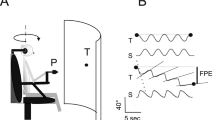Abstract.
We proposed to study and quantify the anteroposterior component, on top of the lateral one, of the body sway induced by different configurations of galvanic vestibular stimulation (GVS) in order to advance the understanding of the orientation of the response. Four stimulation configurations were used in two separate experiments: monaural, binaural, and opposite double monaural in the first experiment (11 subjects); monaural and double monaural in the second (13 subjects). The postural response of the subjects, standing with their eyes closed, to the stimulus (0.6 mA, 4 s) was assessed by measuring the displacement of the center of pressure (CoP) using a force platform. As usual, binaural GVS induced a strictly lateral deviation of the center of pressure. The opposite double monaural condition induced a similar lateral sway to that obtained in the binaural mode, although with a very different stimulation configuration. Monaural GVS induced an oblique, stereotyped deviation in each subject. The anteroposterior component comprised a forward deviation when the anode was on the forehead and a backward deviation when the anode was on the mastoid. The lateral component, directed towards the anode as in the binaural design, was twice as large in the binaural than in the monaural mode. The second experiment showed that double monaural stimulation elicited an anteroposterior deviation (backwards when the anode was on the mastoids and forwards when it was on the forehead) that was equivalent to the addition of two complementary monaural configurations. The present results show that monaural stimulation activates one side of the vestibular apparatus and induces reproducible, stereotyped deviations of the CoP in both the anteroposterior and lateral plane. Secondly, binaural GVS appears to result from the addition of two complementary monaural stimulations. Lateral components of the response to each stimulation, being in the same direction, are summed, whilst anteroposterior components, being in opposite directions, cancel each other out. The opposite happens when both labyrinths are polarized in the same way, as in the double monaural configuration. We suggest that the orientation of the response to GVS is a function of the imbalance between right and left vestibular polarization, rather than a function of the actual position of the electrodes.
Similar content being viewed by others
Author information
Authors and Affiliations
Additional information
Electronic Publication
Rights and permissions
About this article
Cite this article
Séverac Cauquil, A., Martinez, P., Ouaknine, M. et al. Orientation of the body response to galvanic stimulation as a function of the inter-vestibular imbalance. Exp Brain Res 133, 501–505 (2000). https://doi.org/10.1007/s002210000434
Received:
Accepted:
Issue Date:
DOI: https://doi.org/10.1007/s002210000434




